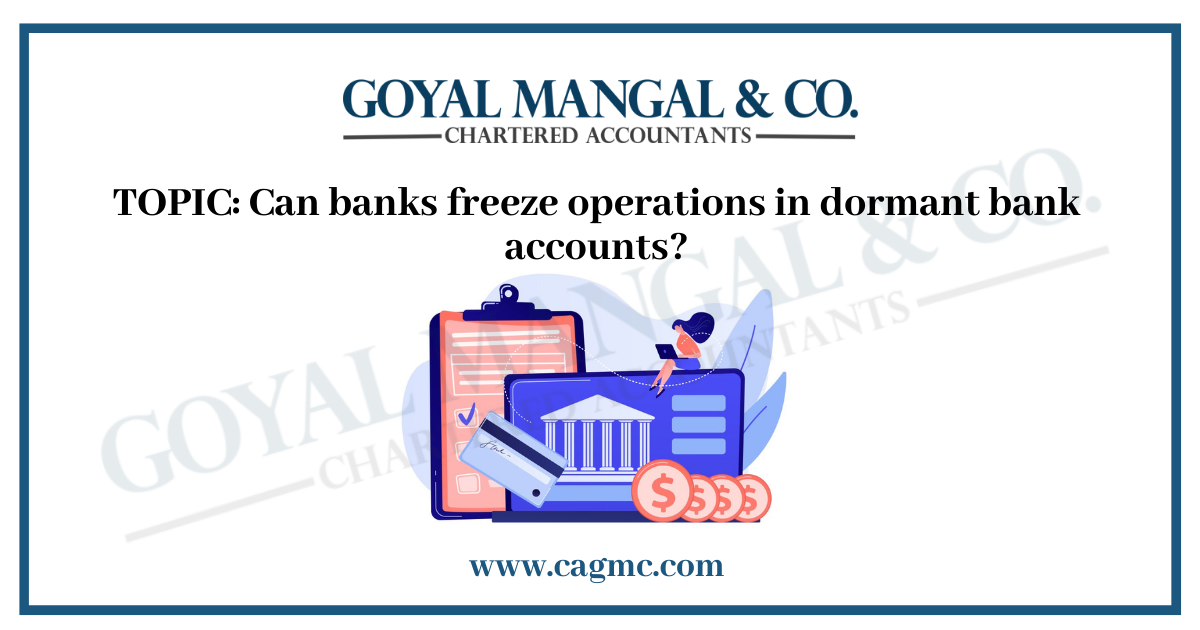
It is common to hold many savings accounts in our name but fail to keep them active. It is not easy to keep track of multiple savings bank accounts. It increases confusion and mismanagement. Not paying attention to managing your inactive bank account can cost you money. In this article, let us have a look at that Can banks freeze operations in dormant bank accounts?
Dormant or Inactive Bank Account
If your Savings or Current account has not recorded any transactions (credit/debit except interest credited to the bank, deduction of service charges, for more than 1 year, the account is deactivated. After more than 2 years, the account is declared inactive/non-functional.
Kinds of transactions to keep the savings bank account active
Any transaction initiated by the customer is sufficient for this purpose. Credit or debit transactions done by the account holder on that account keep it active. Some are listed below-
- Outward and Inward Bill
- Transaction by check.
- Cash deposit
- Deposit by check
- Cash withdrawal or deposit via ATM.
- Internet banking transactions
- Crediting the mandate of interest earned from a fixed deposit to a savings bank account
Why does the bank freeze the savings bank account?
The bank takes this step and deactivates your savings bank account to ensure security and protect your money from the risk of fraudulent transactions for both internal employees and external customers. Once the account is not used for a long time, the bank staff can easily get a sample of the account holder’s past signatures. This makes it extremely easy for them to access their deposited money using withdrawal slips. So, to protect your account from such frauds, banks group it into one cluster and keep the details of inactive accounts in a separate ledger.
What are the consequences of an inactive or dormant account?
An account holder with an inactive account cannot perform many operations. You cannot issue a checkbook, restrictions on account operations are being tightened. The following cannot be claimed-
- Change of address
- Editing a signature
- Add or remove a manager
- ATM/Debit Card Renewal
- No ATM withdrawals
- No transactions either via internet banking or at a bank branch.
How to reactivate a dormant bank account?
A dormant bank account can be reactivated to start operating or close it. The reactivation process varies from bank to bank. For this, the account holder has to make the transaction by check or ATM. If someone has other active accounts, they can send a secure message to the bank from their Personal Internet Banking ID. This must come with an instruction to debit at least a rupee from this account to the other account.
To reactivate an inactive account, submit a duly filled-in application to the bank justifying your absence. Banks are very strict and methodical when it comes to verifying customer credentials before reactivating accounts. The account holder must physically appear with a valid proof of address and a valid proof of identity. He has to take them to the nearest branch to complete the Know Your Customer (KYC) formalities properly. As per RBI guidelines, no charges can be levied for the activation of the dormant account.
What is the difference between a dormant account and a frozen bank account?
They are two separate things. When a bank account is frozen, no transaction can be made until further notice. If the account holder has drawn any checks earlier, payments for the same will be suspended but for all consecutive deposits that are creditable. The Reserve Bank of India, the Securities and Exchange Board, courts, and income tax authorities have the power to get a bank account frozen.
A non-functioning bank account entails a fine, which depends on the policy of the respective bank. The penalty only applies while the account is out of service. This fee is collected annually and is not very high. Customers are also penalized if a minimum account balance is not maintained. Fees vary from bank to bank.
For HDFC Bank, the average minimum account balance in a city/metro is Rs 10,000. It is Rs. 5,000 for accounts maintained in rural or semi-urban areas is Rs.5, 000. A quarterly fee of Rs 750 is charged if this minimum balance is not met. These fees are deducted directly from the account.
However, interest is regularly credited to your savings account even after the account is declared inactive or dormant.
Preventative methods to protect your account from inactivity
There are many of them. Use your account before it becomes inactive or inactive. Make a transaction, withdraw cash, transfer funds through any of the banking channels or make a check payable to ensure your account stays active. Make a transaction once in a while, at least once a year, in all your accounts if you want to escape punishment.
If you’ve moved cities or countries, you can use Internet Banking to transfer small amounts between two accounts. If the account is no longer useful, it is best to cancel the account.
Whether the mandate to credit interest from FD to a savings bank account is a customer-induced transaction?
There may be cases where the customer has been given the mandate to credit the interest from the fixed deposit account to the savings bank account and there are no other operations in the savings bank account. Since the interest rate on Fixed Deposit is credited to the Savings Accounts as per the mandate of the customer, the same should be treated as a customer-induced transaction. Therefore, the account should be treated as an operational account as long as interest from the fixed deposit account is credited to the savings bank account. A savings bank account can only be considered non-functional after two years from the date of the last interest credit on the fixed deposit account.
Final words
The bank depositors’ association should always be on the alert and formally and collectively raise its voice against the illegal actions of the banks. It should refer to other forums if there is a simultaneous failure of regulatory mechanisms to stop such events. If this does not happen, things will not change and individual depositors will continue to be harassed.


